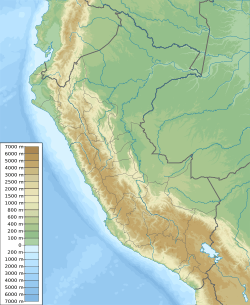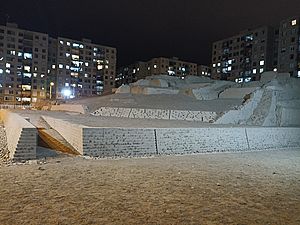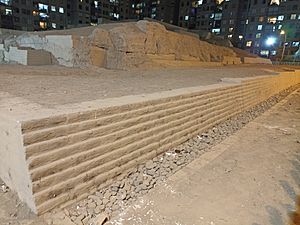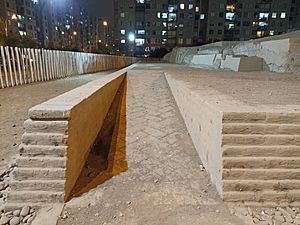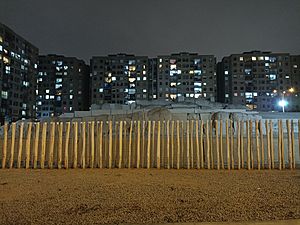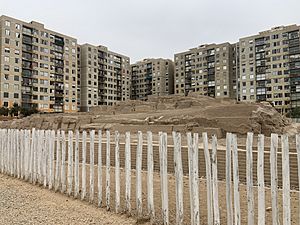Huaca Huantinamarca facts for kids
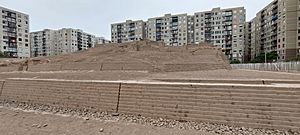
Huaca Huantinamarca in 2022
|
|
| Location | Lima |
|---|---|
| Region | Lima |
| Coordinates | 12°05′00″S 77°05′26″W / 12.08333°S 77.09056°W |
| Type | Settlement |
The Huaca Huantinamarca is an amazing ancient site in Lima, Peru. It was built by the Ichma culture long ago. You can find it in the San Miguel District.
This special place was declared a Cultural Heritage of the Nation on March 27, 2002. This means it is a very important part of Peru's history. It sits near the Rímac River, about 50 meters above sea level. The site covers about 1,500 square meters.
Huaca Huantinamarca is a type of pyramid with a flat top. It was built and changed many times over the years. This makes its design very interesting. The building has many courtyards, rooms, and hallways. These parts were added at different times in its history. The walls were made from mud using a technique called "tapial corrido".
Today, the huaca is part of a public park. It is surrounded by a modern housing area. People in the neighborhood see it as a key part of their history. This helps everyone want to protect it for the future.
Contents
What's in a Name? Origins of Huantinamarca
There are two main ideas about where the name Huantinamarca comes from.
Connected to Water: The Huatica Link
The first idea is that it was linked to the Maranga ancient complex. This complex got water through ditches from the Huatica water channel. Many researchers called the Maranga complex "Huatica" because of this.
An old explorer, Ernst Middendorf, said Maranga was home to a special oracle. This oracle was known as "Huaca" or "Guatan". Also, the famous archaeologist Julio César Tello used "Huatika Marka" for the Maranga Complex in his notes.
The Town of Warts: A Medical Connection
The second idea is that Huantinamarca means "the town of people who suffer from warts". This refers to an illness called "Peruvian wart".
A friar named Fray Diego Gonzáles Holguín wrote about this in 1612. He said that "huantti" in the Quechua language means "warts". So, "huanttivnccytam vncconi" would mean "to be sick of them".
A Journey Through Time: Huaca Huantinamarca's History
Huaca Huantinamarca has had many different uses over its long history.
- It was part of the Maranga complex.
- It was used during the Late Horizon period.
- Later, it became an ancient burial ground.
- Spaniards lived there after the conquest.
- People believed it had strong magical powers.
- It was a cemetery during the time of the Republic.
- It became an old ruin in the countryside.
- It was even an auditorium for fairs.
- Today, it is the main feature of a public park.
Timeline of Huaca Huantinamarca's Occupation
This timeline shows the three main periods when people used Huaca Huantinamarca.

Ancient Times: The Pre-Columbian Period (until 1532 AD)
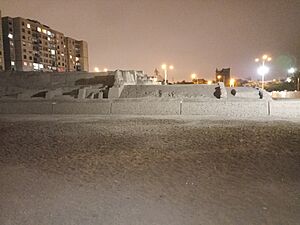
Studies in 2009-2010 found two main building phases at Huantinamarca. In the first phase, walls of different sizes were built. Many were 40 or 80 cm thick. Builders smoothed the surfaces by hand, leaving finger and hand marks.
In the second phase, walls were made with regular blocks. Some parts were trapezoid-shaped, wider at the bottom for stability. These walls have lost their original outer layer today.
Huantinamarca was part of the Maranga complex. It was a central place for a community. People gathered there to collect, prepare, and drink corn chicha. This drink was used in celebrations and rituals. These events were often linked to the farming calendar.
Archaeologists found broken pottery, vessels, and offerings during digs. These items are from the late Ichma period. Some also show influences from the Chancay and Chimu cultures. In 2010, 25 tombs were found with about 100 human bodies. Hundreds of ceramic pots and textiles were also discovered. This huaca was used for work, religious worship, public meetings, and as a cemetery.
The buildings show that the last time people lived here was during the Late Horizon period. This was from 1476 AD to 1532 AD. This was when the Incas ruled the central coast.
Spanish Rule: The Colonial Period (1532 AD to 1821 AD)
After the pre-Columbian period, the building became a mausoleum, a grand tomb. Later, during Spanish colonial times, it was used to control water for irrigation. Its high position also made it a great lookout spot. People could see nearby farms and the ocean. This helped them spot pirates coming from the sea.
The Spanish changed Huantinamarca for their own uses. Archaeologists found Spanish items in the southwest part of the platform. These included plates, cups, bowls, and pots. They also found a leather shoe, a glass bead, and a playing card. In one burial site, a person was found with sharp wounds on their left arm.
Modern Times: The Republican Period (1822 AD to Present)
Even in modern times, people have found evidence of rituals here. These include "payments to the land" and buried offerings. These practices are part of shamanistic rituals. People believe that ancient sites still hold magic, power, and sacredness.
In the 20th century, the San Miguel district grew. Many people and companies bought land for homes and businesses. From the 1960s, Huantinamarca was part of the Pacific Commercial Fair. It was even a stage for concerts at the Home Fair. This actually saved Huantinamarca from being destroyed. It was not built over during the urban growth of the late 20th century.
Later, the land became a residential area. Huaca Huantinamarca then became the center of the "Parques de la Huaca" housing complex.
Huaca Huantinamarca Today
Saving Ancient Sites: From Deterioration to Recovery
Studies and restoration projects at other sites helped change how people saw these places. Sites like Huallamarca, Huaca Pucllana, and Puruchuco showed that ancient sites should not be torn down. They also helped people learn about the old societies that built them. Huantinamarca was once abandoned and falling apart. But thanks to new ideas, it was saved and restored.
A New Home: The Real Estate Project
In May 2009, construction began on the "Parques de la Huaca" condominium. This is the official name of the housing project around Huantinamarca.
The way Huantinamarca looks today is thanks to a team of experts. This team included archaeologists, architects, landscape designers, and restorers. They looked at ancient textiles, plants, and how the site looked. All these things helped them design the new area.
A Model for the Future: Current Situation
The Huantinamarca housing project has achieved a great goal. The ancient monument is now part of the daily lives of the people who live there. They feel a special connection to it. Huantinamarca is a great example. It shows how building companies can protect and improve a nation's cultural heritage.
See also
 In Spanish: Huaca Huantinamarca para niños
In Spanish: Huaca Huantinamarca para niños


